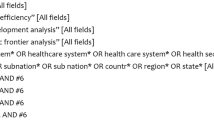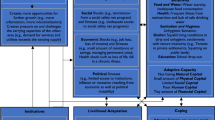Abstract
This study investigates disparities in healthcare services in the districts of Uttar Pradesh, the most populous and one of the poorest states of India in the health sector. To measure the disparities in healthcare services, a composite index has been computed using Principal Component Analysis in three domains namely, health availability, health amenities and health affordability and 12 representative indicators. On the basis of the results, districts have been clubbed into five categories, such as high, high-medium, medium, medium–low and low according to their composite scores. The study also uses k-means cluster analysis to find out the set of districts which are similar within the group, but they are different between the groups. Key results indicate that the districts of the western region are more developed in comparison to the districts of the eastern region in terms of three indices such as availability, amenities, affordability of healthcare services and overall composite health index. Also, k-means cluster analysis shows that there are many districts which are identical in many respects; however, they are located in different regions of the state. This study may be helpful to understand the poor availability and affordability of healthcare services in the districts of Uttar Pradesh, which should be improved to meet the objectives of the basic-needs approach and the millennium development goals.





Similar content being viewed by others
Availability of data and material
Government open access sources, NFHS 2015–16 (Government of India), data from the Uttar Pradesh official site, Government of Uttar Pradesh, India and National Sample Survey 75th round data for the year 2018–19.
Code availability
Arc GIS and SPSS version 22 are used for analysis and we have permission for the use of these software.
References
Ahmad, A., Ghazanferullah, Firdaus G., (2009). Micro regional planning in health facilities in Bulandsahar district. The Geographer, 56(2): 42-51.
Ali, O., Isa, Z. M., & Rahaman, M. R. A. (2004). The effect of urbanization on the health of urban residents. Akademika, 65(July), 111–124.
Armentha, B., Rathi, N., Assasnik, N., & Kamimura, A. (2018). Structural quality of healthcare facilities in India. Internal Journal of Health Care Quality Assurance, 31(6), 483–488.
Arora, A., & Singh, S. P. (2017). So why is Uttar Pradesh still poor? Poverty incidence and its correlates: An inter-regional analysis. International Journal of Social Economics, 44(12), 2351–2377.
Banerjee, A., Deaton, A., & Duflo, E. (2004). Wealth, health and health services in rural Rajasthan. American Economic Review, 94(2), 326–330.
Basel, S., Gopakumar, K. U., & Rao, R. P. (2020). Testing club convergence of economies by using a broad-based development index. GeoJournal. https://doi.org/10.1007/s10708-020-10198-0
Baru, R., Acharya, A., Acharya, S., Shiva, A. K., & Nagraj, K. (2010). Inequalities in access to health services in India: Caste, class and religion. Economic and Political Weekly, 45(38), 49–58.
Bergman, L.R., and Magnusson, D. (2001). Person-centred Research, In International Encyclopedia of the Social & Behavioral Sciences. In T. Cook & C. Ragin (Eds.), Logic of inquiry and research design. Vol. 8 of the International Encyclopedia of the Social and Behavioral Sciences.
Census of India (2011). Annual Health survey, registrar general of India, Ministry of home affairs, Government of. India, Available at: http://www.censusindia.gov.
Clegg, E. J., & Garlick, J. P. (1979). The ecology of disease in urban societies. Current Anthropology, 20(4), 798–799.
Das, A., Das, M., & Barman, H. (2019). Access to basic amenities and services to urban households in West Bengal: Does its location and size of settlements matter? GeoJournal. https://doi.org/10.1007/s10708-019-10101-6
Debroy, B., & Bhandari, L. (2003). District-Level Deprivation in the New Millennium. Delhi: Konark Publishers.
Gordon, A., & Henderson, J. (1977). An algorithm for Euclidean sum of squares classification. Biometrics, 33(2), 355–362.
Government of India, GOI (2000a), National Population Policy, Department of Family Welfare, Ministry of Health & Family Welfare, GOI: New Delhi.
Government of Uttar Pradesh (2018). The Uttar Pradesh Health Policy, 2018 Delivering on health - towards building a robust, resilient and responsive health system, http://ayushmanbharat.mp.gov.in/uploads/media/UP_Health_Policy_Draft_Final_18_Jan_01_00am_CET.pdf.
Greco, S., Ishizaka, A., Tasiou, M., & Torrisi, G. (2018). On the methodological framework of composite indices: A review of the issues of weighting, aggregation, and robustness. Social Indicator Research, 141(1), 61–94.
Guagliardo, M. F. (2004). Spatial accessibility of primary care: Concepts, methods and challenges. International Journal of Health Geographics, 3(1), 3.
Gupta, I., & Ranjan, A. (2019). Public expenditure on non-communicable diseases & injuries in India: A budget-based analysis. PLoS ONE, 14(9), e0222086. https://doi.org/10.1371/journal.pone.0222086
Guptha, K. S. K., & Rao, R. P. (2018). The causal relationship between financial development and economic growth: An experience with BRICS economies. Journal of Social and Economic Development, 20(2), 308–326.
Hartigan, J., & Wang, M. (1979). A K-means clustering algorithm. Applied Statistics, 28, 100–108.
Hirschberg, J. G., Maasoumi, E., & Slottje, D. J. (1991). Cluster analysis for measuring welfare and quality of life across countries. Journal of Econometrics, 50, I31-150.
Johnson, R. A., & Wichern, D. W. (1999). Applied multivariate statistical analysis. Prentice-Hall.
Khan, A. A. (1985). Analyzing spatial disparities in access to health care: A methodology with application in Bangladesh. GeoJournal, 10, 91–107.
Khan, N. (2018). Obstetric complications and delays in seeking emergency care in poor settings of northern India. International Journal of Human Rights in Healthcare, 11(5), 333–346. https://doi.org/10.1108/IJHRH-10-2017-0057
Kothari, C. R. (1990). Research methodology: Methods and techniques. New Delhi: New Age International Publishers.
Krishnan, T. N. (1999). Access to health and the burden of treatment in India: An interstate comparison. In M. Rao (Ed.), Disinvesting in health: The World Bank’s prescription for health (pp. 212–230). SAGE Publications.
Kumari, R. (2016). Regional disparity in Uttar Pradesh and Bihar: A disaggregated level analysis. Journal of Social and Economic Development, 18, 121–146.
Kumari, R., & Kumari, G. (2020). Determinants of child malnutrition in Uttar Pradesh. Artha Vijnana, 62(4), 356–378.
Lai, D. (2003). Principal component analysis on human development indicators of China. Social Indicator Research, 61(3), 319–330.
Majumider, A., Mazumdar, K., & Chakrabart, S. (1995). Patterns of inter- and intraregional inequality: A socio-economic approach. Social Indicators Research, 34, 325–338.
Morris, D. M. (1979). Measuring the condition of the world’s poor: the physical quality of life index. Pergamon.
Narang, R. (2010). Determining quality of public health care services in rural India. Clinical Governance: An International Journal, 16(1), 35–49.
NITI Aayog (2019). Healthy states progressive india-report on the ranks of states and union territories,http://social.niti.gov.in/uploads/sample/health_index_report.pdf.
OECD. (2008). Handbook on constructing composite indicators: Methodology and user guide. OECD Publishing.
Patricia, J., & Roger, J. (2010). Only when the boat has started sinking: A maternal death in rural north India. Social Science & Medicine, 71(10), 1711–1718.
Pearson, K. (1901). On lines and planes of closest fit to systems of points in space. Philosophical Magazine and Journal of Science, 2(11), 559–572.
Peter, D. H., Garg, A., Gery, B., Walker, D. G., Brieger, W. R., & Rahman, H. M. (2008). Poverty and access to health care in developing countries. New York Academy of Sciences, 1136, 161–171.
Prinja, S., Bahuguna, P., Pinto, A. D., Sharma, A., Bharaj, G., Kumar, V., Tripathy, J. P., Kaur, M., & Kumar, R. (2012). The cost of universal health care in India: a model based estimate. Plos One, 7(1), e-30362.
Quackenbush, J. (2002). Microarray data normalization and transformation. Nature Genetics, 32(4), 496–501.
Ram, R. (1982). Composite indices of physical quality of life, basic needs fulfilment, and income. A ‘principal component’ representation. Journal of Development Economics, 11(2), 227–247.
Rani, M., Sekhar, B., & Harvey, S. (2008). Differentials in the quality of antenatal care in India. International Journal for Quality in Health Care, 20, 62–71.
Rao, M. V. V., Kumar, S., & Brahman, G. N. V. (2013). Study of the geographical clustering of districts in Uttar Pradesh using nutritional anthropometric data of preschool children. Indian Journal of Medical Research, 137(1), 73–81.
Sen, A. K. (1985). Commodities and capabilities. North-Holland.
Shafi, M. (1960). Measurement of agricultural efficiency in Uttar Pradesh. Economic Geography, 36(4), 296–305.
Shafiqullah, S. (2011). Regional analysis of urban-rural differentials in literacy in Uttar Pradesh, India. Journal of Geography and Regional Planning, 4(5), 287–296.
Simon, T.D. (2008). Healthcare accessibility in Kerala: An analysis across different socioeconomic groups, Paper presented at the annual conference on ‘equality, inclusion and human development’ of the human development and capability association (HDCA), New Delhi, 10–13, September.
Slottje, D. J. (1991). Measuring the quality of life across countries. The Review of Economics and Statistics, 73(4), 684–693.
Tiwari, A. K. (2008). Economic infrastructure and agricultural development in Himachal Pradesh: A district level analysis. Social Change, 38(2), 245–262.
Tripathi, A. (2019). Doubling the farmers’ income in Uttar Pradesh by 2022: Opportunities & Constraints. Delhi: Institute of Economic Growth.
Tripathi, T., & Mishra, N. K. (2014). Access to public health services: A disaggregated level analysis of Uttar Pradesh. Margin—The Journal of Applied Economic Research, 8(3), 257–284.
UNDP (1990). Human Development Report 1990. New York: Oxford University Press.
UNICEF (2012). UN Children's Fund (UNICEF), UNICEF Annual Report 2012. https://www.refworld.org/docid/51ee31214.htm.
UNICEF (2016). State Nutrition Mission in Uttar Pradesh Pushing the Nutrition Agenda Forward. New Delhi. United Nation Development Programme (1990). Human Development Report. New York: United Nations.
Upadhyay, R. P. (2012). An overview of the burden of non-communicable diseases in India. Iran Journal of Public Health, 41(3), 1–8.
Ye, H., & Kim, H. (2015). Analyzing the spatial pattern of primary care physician locations in Hillsborough County. Florida. Papers in Applied Geography, 1(1), 79–85.
Youkta, K., Paramanik, R.N. (2020). Convergence analysis of health expenditure in Indian states: Do political factors matter? GeoJournal. https://doi.org/10.1007/s10708-020-10313-1.
Funding
No funding for this study. I declare that this manuscript is neither published nor communicated for any other journal.
Author information
Authors and Affiliations
Contributions
RK-data analysis, data collection, tabulation, mapping, and analysis work. RR-Proof-reading, analysis work, result interpretation.
Corresponding author
Ethics declarations
Conflict of interest
No conflict of interest.
Ethical approval
This manuscript is not submitted to more than one journal and this is original, not an expansion of previous work and not published elsewhere in any form or language. Results are presented clearly, honestly and without fabrication, falsification or inappropriate data manipulation. We have followed editorial ethics and academic ethics in this manuscript. The authors have not used their own works which have published earlier. We have not used any unethical languages in any part of the manuscript.
Consent to participate
We have used scientific method of research without any field observation.
Consent for publication
We wanted to get it publish in this journal.
Additional information
Publisher's Note
Springer Nature remains neutral with regard to jurisdictional claims in published maps and institutional affiliations.
Rights and permissions
About this article
Cite this article
Kumari, R., Raman, R. Regional disparities in healthcare services in Uttar Pradesh, India: a principal component analysis. GeoJournal 87, 5027–5050 (2022). https://doi.org/10.1007/s10708-021-10542-y
Accepted:
Published:
Issue Date:
DOI: https://doi.org/10.1007/s10708-021-10542-y




